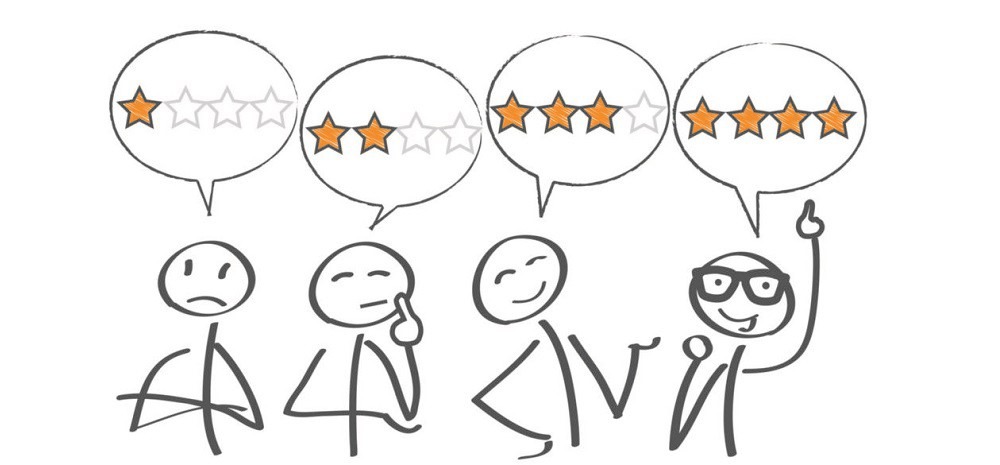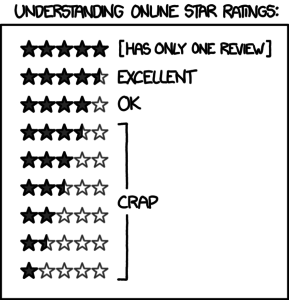Ratings and Reviews: Are there too many influencers influencing me?
Online ratings are of two types: one-way ratings and multi-way feedback

Let me begin by saying I am 33 years old so the natural sarcasm and dystopia is in full bloom.
More importantly, I am a big Shah Rukh and Farhan Akhtar fan. Up until 2010 or so (Don 2 and Rock On era) I saw almost all their movies at my local PVR. After the movie, I would dissect it in detail over a delicious meal at a closest restaurant and/or bar and took an auto to conclude an amazing Saturday night. Overall, that “movie day” was something I was excited about pretty much every other week or so!
Fast forward 7 years my “new” Saturday night turns into a reviews parsing nightmare – usually begins with first validating the movie reviews (a normal threshold is 4 stars), if I can get pass the movie ratings getting to a 4-star restaurant/bar was hard, click a few self-portraits and food images to be posted on Instagram, next I have to wait for a 4.7+ Ola/Uber driver and give him ratings at the end of my ride and ultimately ending my night hoping that I get enough likes on my Instagram (less than 15 is detrimental to my confidence which usually HAS to be followed up by a clean and filtered image of food porn).
Online Ratings
What happened to my Saturday night? two things changed for me: online social presence and these damn … Online Ratings.
Social presence well can’t fix that now, but let’s just try to understand what exactly are Reviews (or Ratings). Ratings to me are a mechanism of exchanging trust among a set of stakeholders which involves a threshold value and a likely outcome of a polar opinion.
Online ratings are mainly of two types: one-way or influential ratings and multi-way feedback or a controlled arrangement mostly in sharing economy.
We will keep controlled arrangement out of this for now, because it’s a lengthy topic. However, both these types of ratings are flawed to an extreme degree in my opinion and are taking us to a nosedive.
Influential Ratings
Let’s focus on influential ratings. I would consider e-Commerce (e.g. Amazon, Flipkart, etc) reviews, Movie reviews, Restaurant reviews should fall under this category. The basic idea is that few “reviewers” (usually early adopters with relatively higher disposable income) buy/see/eat these products/movies/food and then express their “opinion” in terms of ratings for them.
In turn potential buyers are “influenced” by these ratings before making their purchase decision within a given threshold. In short, if you see something <3.5 stars across industries chances are you will not buy it.
Too much jargon? Picture this – Let’s say you want to buy Samsung Galaxy On8 on Amazon. It is rated 3.7 stars (as of this writing). Chances are you will either reject it or probably keep it in your B-list.
No one else will do this, but let me take a deeper dive on these 3.7 stars which is a simple average out of 671 reviews. Okay here it is:
118 reviewers rated it 1-star => 17.5% of influencers basically said its terrible.
At least 40 reviews out of these 118 reviews contribute nothing => ~6% overall
“Like”, “Its A Copy of Samsung J7 2016”, “Not a good phone” etc
If you omit these reviews the ratings could jump to ~4 it might be a different perception for consumers? Maybe. At a bare minimum you will move this to your A-list.
Generalization of such issues with influential ratings can be summarized as:
- Strange amount of power for “reviewers”: They rate a product based on their just out of disgust or have nothing in common with how you will use the product or maybe are just wrong!
- Negative downward network effects: Since most people have a defined threshold (<3.5 stars) the less people buy a product lower are the chances of ratings going up. In effect, it’s highly unlikely that ratings of such product will ever go up. Hence, companies might be unnecessary forced to dump a new version of same product on you.
- Influence the influencers strategy: This is where it gets alarming. Companies might try and give free products to influencers to hope that moral obligations will get them a good review. On the extreme side you might see fake reviews to promote or downgrade a product. Fakespot (http://fakespot.com/) anyone?

CREDIT – https://xkcd.com/1098/
What can we do?
Question is what can we do? We can at least start with few basic changes;
- Filters to weed out ratings: I would love to just have simple filters to weed out reviews and see the ratings go up or down based on my filters.
- Omit less than 20 words in review
- Cross-product reviews (other products the reviewer has bought)
- Click to omit multiple reviews
- Uniform rating score: Websites can potentially come up with a unified unbiased score for products based on a complex algorithm. This score can be based on reviews, purchases, clicks, seller etc. That way I can see an influencer rating but also a consolidated score.
- Just try it!!: Okay you might say but WHY? Here is my argument – first let’s restrict ourselves to under 5000 bucks here. The category will most likely be movies, food and probably small home products. If we as consumer start trying more two things will happen
-
- We will like the product therefore creating brand loyalty and less chaotic ratings to tell us about our next purchases thereby companies can target us directly.
-
- We will dislike the product and can rationalize and ask for our money back thereby forcing a better return policy instead of more versions (Okay – not applicable on movies but you get it)
Overall, let’s stop the inundation of ratings and reviews which in turn results in thousands of versions of the same product or too many influencers influencing (read – confusing) us.
I will be honest; this one is tricky but we can definitely influence the companies (get it?) to some degree. And more importantly I can see Lucknow Central please!!
Please rate me using comments below. Thank you.
